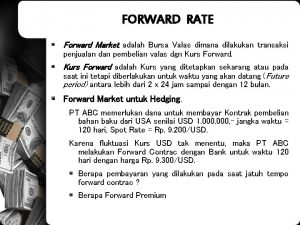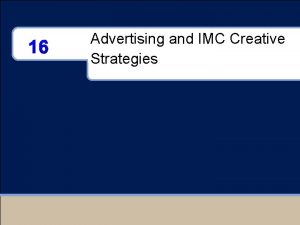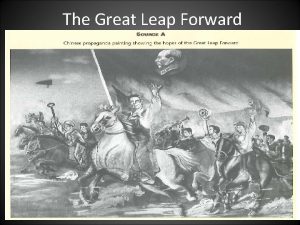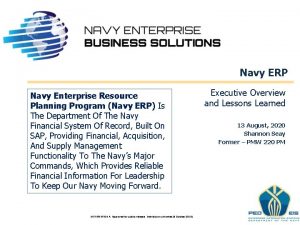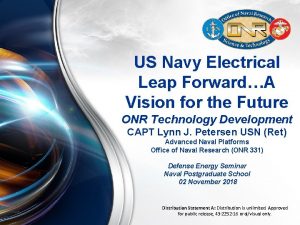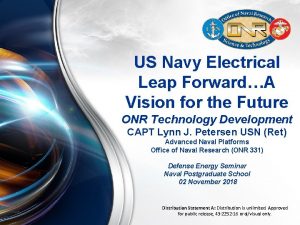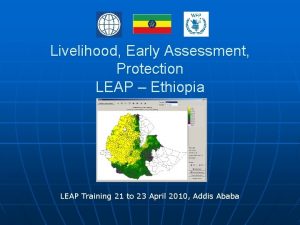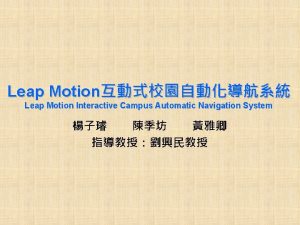U S Surface Navy Electrical Leap Forward a















- Slides: 15

U. S. Surface Navy Electrical Leap Forward… …. a Vision for the Future Defense Energy Summit Naval Post Graduate School 02 November 2018 Mr. Stephen P. Markle, PE Electric Ships Office (PMS 320) Director & Program Manager 202. 781. 4427 Distribution Statement A: Approved for Public Release: Distribution is unlimited. stephen. markle@navy. mil

Power System Considerations “I’m going to buy as much as I can afford. As much power as I can afford. Because I know by the time I retire the ship I’ll use it all. ” Admiral John Richardson 31 st U. S. Chief of Naval Operations Directed Energy Summit I March 29, 2017 Ø Buy as much power as you can afford • Power (esp. with electric propulsion) is fundamental to ship design and affects major components, arrangements, superstructure, compartmentalization, & ship control Ø The power system must include a better approach to distribution flexibility throughout the ship’s service life; current design practices optimize for current requirements • • DDG 1000 has plenty of installed power but a distribution system limited to current requirements DDG 51 Flight III includes a costly power system upgrade for AMDR that was not in the original design Ø Follow the N 96 Surface Capability Evolution Plan (SCEP) The Electric Power System is the Foundation of the Ship’s Kill Chain Distribution Statement A: Approved for Public Release: Distribution is unlimited. 2

Evolution of the next large surface combatant… FUTURE FORCE STRUCTURE “The prioritized shipbuilding plan assigns the highest priority to frontline combat platforms, affording the opportunity to quickly adopt new capabilities in response to emerging disruptive capabilities…” Annual Long-Range Plan for Construction of Naval Vessels (2019) DISRUPTIVE TECHNOLOGY Ø High energy weapons and sensors required to pace technology, outpace adversaries, and maintain maritime dominance Ø Maintain flexibility to rapidly introduce new mission systems Naval Directed Energy Weapons and Sensors Weapon Demand Sensor Demand EW Demand Mission Capability Key to Disruptive Technology is an Agile Power System… Distribution Statement A: Approved for Public Release: Distribution is unlimited. 3

Future Surface Combatant UNCLASSIFIED Evolution of Surface Combatant DDG 79 Flt IIA - 2000 DDG 51 Flt I 1991 DD 963 - 1975 DDG-72 Flt II - 1998 ASW/ASUW DDG 125 Flt III – FY 23 Strike/AAW/ASW/ASUW CG 47 - 1983 Land Attack/AAW/ASUW DDG 1000 - 2016 LCS 1 - 2008 FSCF LSC / SSC / USV FFG(X) LCS 2 - 2010 Distribution Statement A. Approved for public release: distribution unlimited. 4

Directed Energy Mission System Power Demands Power = Energy/Time or Energy = Power x Time POWER Generator Response to Load Sensor Demand Mission Capability TIME Future Energy Storage Response to Load Sensor Demand POWER Current ENERGY STORAGE PROVIDES PULSE POWER GENERATOR CHARGES ENERGY STORAGE TIME Weapon Demand Kinetic Weapons • Generators operate at continuous loading for efficiency & reliability • Current generators cannot respond quickly and dynamically to new demands EW Demand ? Current Demand Future Demands Directed Energy Weapons and Sensors • Pulses of a different nature require different ranges of pulse power technologies • Future directed energy demands need common large scale energy storage Key to Success = Energy Storage and Advanced Controls Distribution Statement A: Approved for Public Release: Distribution is unlimited. 5

PATH TO THE FUTURE Power is the Foundation of the Kill Chain • Share energy storage for new dynamic loads • Minimize space, weight and cooling impacts • Utilize maximum power a ship can provide Path to the future Shift the power interface MIL-STDLVDC/MVDC Validation Develop a common intermediate power and energy system Advance Fully Integrated Power and Energy Systems ENERGY MAGAZINE IPES Back fit / Forward fit New Ship Design Distribution Statement A: Approved for Public Release: Distribution is unlimited. I 6

The Guidebook: NPES TDR Naval Power and Energy Systems Technology Development Roadmap Ø Aligned to the Navy’s 30 year shipbuilding plan and Surface Capability Evolution Plan (SCEP) Ø Serves as a guide for future investment by Navy, Do. D, Industry, and Academia Ø Includes all major product areas for Naval Power Systems • Prime Movers • Generators • Energy Storage • Electric Motors • Distribution Systems • Power Converters • Controls Ø Originally issued in 2007 as part of the stand-up of the Electric Ships Office Ø Updated and re-issued in 2013 & 2015 Ø 2018 Version utilized CPES OIPT input 2018 Version Currently in chop for SEA 00 Signature Distribution Statement A: Approved for Public Release: Distribution is unlimited. 7

FLORIDA STATE UNIVERSITY CENTER FOR ADVANCED POWER SYSTEMS Emulated Power System Compact Power Emulated Mission Systems AMDR PCM FESS Device(s) Under Test EM-L Real Time Simulation: Technical and Programmatic Risk Reduction Distribution Statement A: Approved for Public Release: Distribution is unlimited. I 8

DEMONSTRATION Modeling & Simulation • DDG 51 Flt IIA & III VV&A’d Electrical System • Detailed Mission Systems, including: SEWIP Laser AMDR + Energy Storage Models & Hardware Real Time Dynamic Simulation FSU CAPS EM-L (DRS) Knowledge FESS (GKN/UK) JHU APL Adaptive Power System (APS) Control Hardware in the loop (CHIL) Power Hardware in the loop (PHIL) + Power & Energy Management • Sandia NL Distributed Energy Management Demonstrations Validate Interfaces for Pulsed High Energy Systems Distribution Statement A: Approved for Public Release: Distribution is unlimited. I 9

IPES REQUIRED Integrated Power System (IPS) Architecture: Shares Propulsion Plant with Ship 1000 Service Electric Gas Turbi ne Generat or Distribution Fuel TOTAL SHIP POWER Motor Ship Service & Weapo ns Integrated Power & Energy System (IPES) = Energ IPS + Shared Energy + Advanced y Stora Controls Electric ge Evolutionary Approach Fuel Gas Turbi ne Power Conversion Generat or Filtration Distribution DDG TO ACCESS Switching IPES Tactical Advantages: • Enable Undefined Future Warfare Capability Adaptability • • Ship Service & Weapo ns Flexibility • • Motor Support Evolving Mission Requirements/ Systems Survivability • • Limit Casualty Impact and Speed Recovery Whole Ship Power Backup Maneuver on “Battery” Engage Until Last Drop of Fuel Expended Industry is currently implementing this concept, e. g. Siemens Blue. Drive, • Endurance/Efficiency providing similar benefits with a significantly smaller footprint, • Greater Range & Time on Station reduced weight, and lower operating costs. Distribution Statement A: Notional Offshore Service Vessel (OSV) with Blue. Drive Approved for Public Release: Distribution is unlimited. I 10

PROGRAM MANAGER THOUGHTS • Fruits of multiple investments in warfighting technology are maturing in near future • LSC Power system attributes driven by evolving Requirements • Technological enablers for the future: • Markle Crystal Ball • Stable Bus servicing highly dynamic DC loads • Marriage between Combat Systems and Machinery Control Systems • “Active State Anticipation” • Uninterruptable Stable Back Up Power • New way to look at Service Life Margin • Total Ship Power Perspective • Flexibility for the Future • Interfaces • Design “For” but “Not Fit With” at build • Innovative data analysis automated decision making • Expanded use of M&S to include heavy reliance on CHIL and PHIL • 12 k. VDC IPES Emulation at FSU CAPS FY 19 • 12 k. VDC power generation and distribution • Dual-wound variable speed prime movers • Efficient low loss power conversion • High frequency power conversion • Wide Band Gap Materials (Si. C, Ga. N, Ga 2 O 3 based devices) • Agile Advanced Controls • Integrated shared and distributed energy storage • Media selected by dynamic responses required • Thermal Electric Power Generation part of the Holy Grail • Thermal Management Technologies • Validated Specifications and Standards Continued Active Partnership with Academia & Industry is Vital Distribution Statement A: Approved for Public Release: Distribution is unlimited. I 11

USS NEW MEXICO (BB 40) – US Navy’s First All Electric Ship Circa 1918 ◆ ◆ ◆ ◆ All the crew in lifeboats All the gun magazines expended All the decoys gone All the coffee consumed Every array face and electric weapon hot to the touch Energy Magazine completely discharged FUEL TANKS EMPTY! A “Nobel End” for an Electric Warship having met an Overmatching Threat… Distribution Statement A: Approved for Public Release: Distribution is unlimited.

Distribution Statement A: Approved for Public Release: Distribution is unlimited.

Preparing the Test Bed for DDG 51 Flight III AMDR PCM Verification, Validation & Accreditation Letter Feb 2016 ◆ Triton PCM 4 880 KW used as surrogate ◆ ONR 331/ PMS 320 (50/50) (Approx. $150 K each) to refurbish and set to work @ FSU CAPS ◆ Compact power: tested at FSU CAPS 4 th QTR 2014 (3 months) tested at NSWCPD LBTS 1 st QTR – 3 rd QTR 2015 (9 months) ◆ Models validated/tested, accreditation letter signed February 2016 ◆ AMDR PCM Tested at FSU CAPS, October 2017 (available for test at NSWCPD today) Distribution Statement D: Distribution authorized to the Department of Defense and U. S. Do. D contractors only. Other requests shall be referred to PMS 320, Electric Ships Office Program Manager / Director. 14

INVESTMENT Upgrade Technology 2013: Energy Storage Module-Land (ESM-L): Proof of Concept for SSL-TM Land Demo Testing Lead acid battery based technology in Upgrade 28’ conex for box 2018: Energy Magazine Laser (EM-L) ESM Capability in 1/10 the size with lithium batteries Supports Laser Engagement Profiles 2019: Multi-function Energy Storage Module (MFESM) Power Electronics with Hybridized Energy Storage: Batteries + Capacitors Shipboard Use 2019: Energy Storage Module-Ship (ESM-S): Second ESM Unit Modified for SSL-TM on LPD 27 Enables 4 min of SSL operation Incorporate Ship Readiness 2023 Energy Magazine (2020 BES) • • 2020: Combined Energy Magazine (EM) Early Transition of MFESM Batteries with Energy Magazine Prototype Leverage Investmen t 2021: PEBB Expansion 4160 VAC Converter with MFESM Power Electronics Building Blocks 2019: Advanced Circuit Protection For DC Architectures Expand Portfolio Energy Magazine Stores and Provides Energy from Ships Power Electronics Energy Storage to Directed Energy Weapons & Sensors “Reloadable” Magazine Distribution Statement D: Distribution authorized to the Department of Defense and U. S. Do. D contractors only. for multiple engagements Other requests shall be referred to PMS 320, Electric Ships Office Program Manager / Director. 19
 Communism in china ap world history
Communism in china ap world history Chinese great leap forward
Chinese great leap forward Great leap forward propaganda
Great leap forward propaganda Great leap forward communes
Great leap forward communes Okc ppt
Okc ppt Feudal system definition
Feudal system definition Chinese great leap forward
Chinese great leap forward Forward market
Forward market Forward rate dan forward market
Forward rate dan forward market Curved surface area of cone
Curved surface area of cone Triangular prism lateral surface area
Triangular prism lateral surface area High surface tension vs low surface tension
High surface tension vs low surface tension Leap.laa.edu.ph
Leap.laa.edu.ph Leap 2025 score ranges
Leap 2025 score ranges Creative leap meaning
Creative leap meaning Leap program douglasville ga
Leap program douglasville ga








